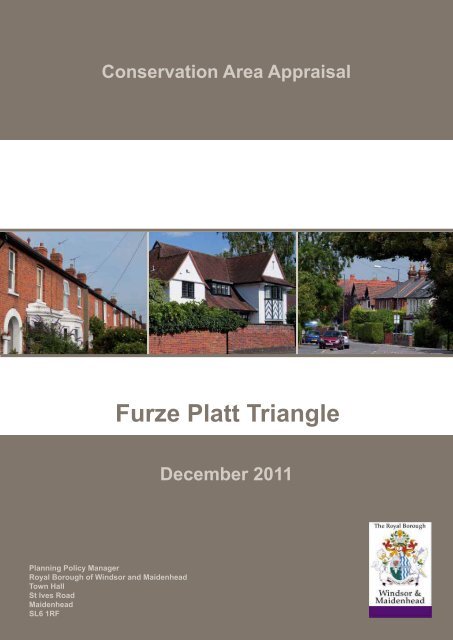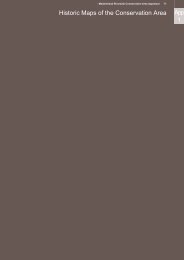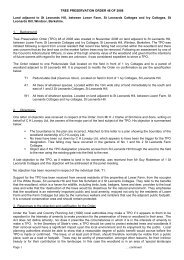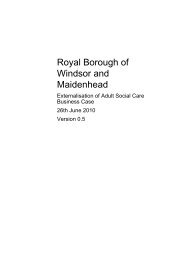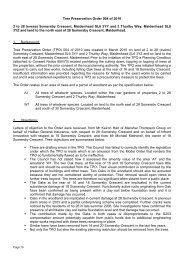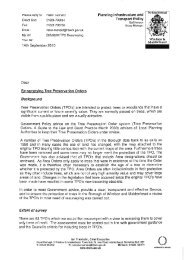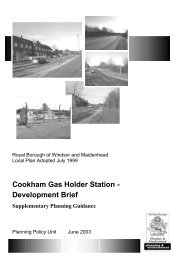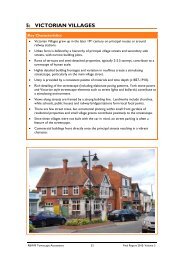Furze Platt Triangle - The Royal Borough of Windsor and Maidenhead
Furze Platt Triangle - The Royal Borough of Windsor and Maidenhead
Furze Platt Triangle - The Royal Borough of Windsor and Maidenhead
- No tags were found...
Create successful ePaper yourself
Turn your PDF publications into a flip-book with our unique Google optimized e-Paper software.
Conservation Area Appraisal<strong>Furze</strong> <strong>Platt</strong> <strong>Triangle</strong>December 2011Planning Policy Manager<strong>Royal</strong> <strong>Borough</strong> <strong>of</strong> <strong>Windsor</strong> <strong>and</strong> <strong>Maidenhead</strong>Town HallSt Ives Road<strong>Maidenhead</strong>SL6 1RF
<strong>Furze</strong> <strong>Platt</strong> <strong>Triangle</strong> Conservation Area AppraisalContentsForeword4Introductory Chapters1 IntroductionWhat does Conservation Area designation mean?What is the purpose <strong>of</strong> Conservation Area Appraisals?What is the status <strong>of</strong> this document?2 Planning Policy Context3 Background4 Summary <strong>of</strong> Special Interest5 Location, Setting <strong>and</strong> Development <strong>of</strong> the AreaLocation <strong>and</strong> SettingTopography <strong>and</strong> GeologyHistory <strong>and</strong> DevelopmentArchaeology6 <strong>The</strong> General Character <strong>and</strong> Form <strong>of</strong> the Area7 Special Features <strong>of</strong> the AreaListed BuildingsImportant Non Listed BuildingsBuilding Materials <strong>and</strong> Architectural DetailsTreesOpen SpacesBoundariesStreet FurniturePaving <strong>and</strong> Surface TreatmentsImportant Views, Vistas <strong>and</strong> L<strong>and</strong>marksUses8 Opportunities for Enhancement <strong>and</strong> ChangeNegative AreasConditionEnhancement OpportunitiesSensitivity to Change9 Map <strong>of</strong> Main Features <strong>of</strong> Conservation Area66661012141818181828303636363637373842434448505050515154
<strong>Furze</strong> <strong>Platt</strong> <strong>Triangle</strong> Conservation Area AppraisalContentsAppendices1 Significant Non-Listed Buildings Descriptions <strong>and</strong> Images2 Description <strong>of</strong> Conservation Area Boundaries3 Bibliography4 Consultation Process56687072Five Year Management PlanFive year Conservation Area Management Plan74
- <strong>Furze</strong> <strong>Platt</strong> <strong>Triangle</strong> Conservation Area Appraisal3Foreword
4<strong>Furze</strong> <strong>Platt</strong> <strong>Triangle</strong> Conservation Area AppraisalForewordBy Councillor Mrs Christine BatesonLead Member for Planning <strong>and</strong> Development<strong>The</strong> <strong>Borough</strong> Council has designated a new Conservation Area within the <strong>Furze</strong> <strong>Platt</strong> area <strong>of</strong> <strong>Maidenhead</strong>.<strong>The</strong> area comprises the ‘triangle’ created by Linden Avenue, Courthouse Road <strong>and</strong> <strong>Furze</strong> <strong>Platt</strong> Road.This proposal has been lead by local residents in the area, who have largely written the appraisal document.This is the first time for the <strong>Borough</strong> that local residents have been so heavily involved in the ConservationArea designation process <strong>and</strong> shows that the <strong>Borough</strong> is leading the way in encouraging residents to beinstrumental in policy making. I would encourage others with an interest in their built environment to followthis excellent example.This appraisal document, which describes the important features <strong>and</strong> characteristics <strong>of</strong> the area, will beused when planning decisions are made that affect the area. <strong>The</strong> approach used follows advice set out inEnglish Heritage guidance.<strong>The</strong> <strong>Furze</strong> <strong>Platt</strong> <strong>Triangle</strong> Conservation Area Appraisal also includes a Five Year Conservation AreaManagement Plan, which is intended to summarise the actions that the Council plans to take in the periodto ensure that the character <strong>and</strong> appearance <strong>of</strong> the area is preserved or enhanced.<strong>The</strong> designation <strong>of</strong> new Conservation Areas, in conjunction with the review <strong>of</strong> the existing 26 ConservationAreas, is part <strong>of</strong> a longer-term project to ensure the protection <strong>of</strong> the <strong>Borough</strong>’s historic built environment.A draft version <strong>of</strong> this document was subject to a public consultation exercise during October 2011, <strong>and</strong> thisfinal version contains some amendments made in response to comments received.If you have any questions regarding any aspect <strong>of</strong> the Appraisal or Management Plan, please contact:planning.policy@rbwm.gov.ukorConservation <strong>and</strong> Design TeamPlanning Policy UnitPlanning <strong>and</strong> DevelopmentTown HallSt Ives Road<strong>Maidenhead</strong>SL6 1RF
- <strong>Furze</strong> <strong>Platt</strong> <strong>Triangle</strong> Conservation Area Appraisal5Introduction 1
6<strong>Furze</strong> <strong>Platt</strong> <strong>Triangle</strong> Conservation Area Appraisal1IntroductionWhat does Conservation Area designation mean?1.1 A Conservation Area is an area <strong>of</strong> special architectural or historic interest, the character or appearance<strong>of</strong> which it is desirable to preserve or enhance (Planning (Listed Buildings <strong>and</strong> Conservation Areas) Act1990, Section 69). <strong>The</strong> responsibility for designating Conservation Areas lies with the Local Planning Authority.1.2 <strong>The</strong> aim <strong>of</strong> Conservation Area designation is to protect the wider historic environment. Areas may bedesignated for their architecture, historic street layout, use <strong>of</strong> characteristic materials, style or l<strong>and</strong>scaping.<strong>The</strong>se individual elements are judged against local <strong>and</strong> regional criteria, rather than national. Above all,Conservation Areas should be cohesive areas in which buildings <strong>and</strong> spaces create unique environmentsthat are irreplaceable.1.3 Local Authorities have a statutory duty to review all their Conservation Areas regularly. English Heritagerecommends that each area is reviewed every five years.1.4 Conservation Area Designation provides extra protection within Conservation Areas in the followingways:Local Authorities have general control over most complete demolition <strong>of</strong> buildings within ConservationAreasLocal Authorities have extra control over minor developmentSpecial provision is made to protect trees within Conservation AreasWhen assessing planning applications, Local Authorities must pay careful attention to the desirability<strong>of</strong> preserving or enhancing the character <strong>and</strong> appearance <strong>of</strong> the Conservation Area1.5 <strong>The</strong> Local Authority can include policies within its planning policies to help preserve the specialcharacter <strong>and</strong> appearance <strong>of</strong> Conservation Areas.What is the purpose <strong>of</strong> Conservation Area Appraisals?1.6 <strong>The</strong> aim <strong>of</strong> the Appraisal is to:Identify the Special Architectural <strong>and</strong> Historic Interest <strong>and</strong> the changing needs <strong>of</strong> the ConservationAreaClearly define the Conservation Area boundariesIncrease public awareness <strong>and</strong> involvement in the preservation <strong>of</strong> the areaProvide a framework for planning decisionsGuide controlled <strong>and</strong> positive change within the Conservation Area, thus avoiding mediocrity <strong>of</strong>developmentWhat is the status <strong>of</strong> this document?1.7 A draft version <strong>of</strong> this document was published for public consultation during October 2011, <strong>and</strong> thisprocess is summarised within the appendices. Following the consultation exercise the comments receivedhave been considered <strong>and</strong> some amendments have been made. This final version <strong>of</strong> the appraisal has beenapproved for publication by the Lead Member for Planning <strong>and</strong> Development, <strong>and</strong> endorsed by the Cabinet<strong>of</strong> the <strong>Royal</strong> <strong>Borough</strong> <strong>of</strong> <strong>Windsor</strong>, for use to guide <strong>and</strong> inform all planning considerations <strong>and</strong> other councilactivities in the Conservation Area, on Thursday 15th December 2011.1.8 This Conservation Area appraisal has been prepared in the context <strong>of</strong> national, regional <strong>and</strong> localplanning policy <strong>and</strong> will be used to guide future planning decisions.1.9 <strong>The</strong> contents <strong>of</strong> this appraisal <strong>and</strong> the associated maps <strong>and</strong> appendices are intended to highlightsignificant features but they should not be regarded as fully comprehensive <strong>and</strong> the omission <strong>of</strong>, or lack <strong>of</strong>reference to a particular building or feature should not be taken to imply that it is <strong>of</strong> no significance. Thissignificance may only be fully identified at such time as a feature or building is subject to the rigorousassessment that an individual planning application necessitates.
<strong>Furze</strong> <strong>Platt</strong> <strong>Triangle</strong> Conservation Area Appraisal7Introduction 11.10 Similarly, the controls that apply to elements vary <strong>and</strong> in some instances the items that have beenidentified as significant features cannot be fully protected by planning legislation. Further guidance on thecontrols that apply in conservation areas is given on the council’s website www.rbwm.gov.uk or in the leaflet‘Conservation areas- what they are <strong>and</strong> what it means to live in one’. Copies <strong>of</strong> the leaflet, <strong>and</strong> initial adviceon individual planning queries can be obtained by contacting the Council’s Customer Service Centre eitherin person at the Town Hall <strong>Maidenhead</strong>, via the Council website, or by telephoning 01628 683 810.
8<strong>Furze</strong> <strong>Platt</strong> <strong>Triangle</strong> Conservation Area Appraisal1Introduction
- <strong>Furze</strong> <strong>Platt</strong> <strong>Triangle</strong> Conservation Area Appraisal9Planning Policy Context 2
10<strong>Furze</strong> <strong>Platt</strong> <strong>Triangle</strong> Conservation Area Appraisal2Planning Policy Context2.1 <strong>The</strong> current Development Plan for the area consists <strong>of</strong> the following documents:Regional Spatial Strategy: <strong>The</strong> South East Plan May 2009<strong>The</strong> Replacement Minerals Local Plan for Berkshire incorporating alterations (1997 & 2001);<strong>The</strong> Waste Local Plan for Berkshire (adopted 1998)<strong>The</strong> <strong>Royal</strong> <strong>Borough</strong> <strong>of</strong> <strong>Windsor</strong> <strong>and</strong> <strong>Maidenhead</strong> Local Plan (Incorporating Alterations Adopted June2003).<strong>Maidenhead</strong> Town Centre Area Action Plan (to be adopted in September 2011)2.2 <strong>The</strong> government has signalled its intention to abolish the South East Plan. <strong>The</strong> council intends toproduce a <strong>Borough</strong> Plan, <strong>and</strong> is also working with local communities <strong>and</strong> Parish Councils to produce a series<strong>of</strong> Neighbourhood Plans. <strong>The</strong> <strong>Borough</strong> Plan will address planning issues at a borough level, whileNeighbourhood Plans will look at more local issues. Together, once adopted, they will form the developmentplan for the area.2.3 Until these new plans are established, relevant policies from the Local Plan have been saved <strong>and</strong> willcontinue to guide planning decisions. Several saved policies directly relate to Conservation Areas <strong>and</strong> canbe found in the attached Management Plan.2.4 Further details about local planning can be found on the Council’s website www.rbwm.gov.uk, or bycontacting the Council’s Strategy <strong>and</strong> Plans Team.
- <strong>Furze</strong> <strong>Platt</strong> <strong>Triangle</strong> Conservation Area Appraisal11Background 3
12<strong>Furze</strong> <strong>Platt</strong> <strong>Triangle</strong> Conservation Area Appraisal3Background3.1 This is the first completely new Conservation Area to be proposed within the <strong>Borough</strong> since 1995 <strong>and</strong>as such seeks to highlight the significance <strong>of</strong> <strong>Maidenhead</strong>'s Victorian <strong>and</strong> Edwardian development withinthe town. <strong>The</strong> proposal to designate the <strong>Furze</strong> <strong>Platt</strong> <strong>Triangle</strong> as a Conservation Area has been lead by localresidents in the area, who have defined the proposed boundary, provided the photography, maps, <strong>and</strong>largely written the appraisal document. This is an indication <strong>of</strong> the level <strong>of</strong> local interest in this area.3.2 <strong>The</strong> proposed Conservation Area is within <strong>Furze</strong> <strong>Platt</strong>, a former village, now part <strong>of</strong> suburban<strong>Maidenhead</strong>. <strong>The</strong> area still retains an independent character to <strong>Maidenhead</strong> <strong>and</strong> is bound by countrysideto the north. <strong>The</strong> proposed Conservation Area is within the core <strong>of</strong> <strong>Furze</strong> <strong>Platt</strong> <strong>and</strong> the apex <strong>of</strong> the proposedConservation Area is considered an important nodal point within <strong>Maidenhead</strong>.3.3 <strong>The</strong> area to be included within the proposed Conservation Area is also supported by the identificationin the RBWM 2008 Townscape Characterisation study <strong>of</strong> <strong>Maidenhead</strong>'s 'Victorian Villages' which highlightsthe <strong>Furze</strong> <strong>Platt</strong> area as a unique former Victorian Village.3.4 <strong>The</strong> proposed Conservation Area has been drawn tightly around the 'triangle' <strong>of</strong> <strong>Furze</strong> <strong>Platt</strong> Road,Courthouse Road <strong>and</strong> Linden Avenue. This is considered the section within <strong>Furze</strong> <strong>Platt</strong> that has the mostconcentrated <strong>and</strong> intact Victorian <strong>and</strong> Edwardian development.3.5 <strong>The</strong> existence <strong>of</strong> the <strong>Furze</strong> <strong>Platt</strong> <strong>Triangle</strong> can be traced back at least to the early years <strong>of</strong> the 19 thcentury, when the current Victorian / Edwardian village area can be clearly seen as tracks on a pre-Ordnancesurvey map <strong>of</strong> 1809. Quite exceptionally, the ownership <strong>of</strong> this l<strong>and</strong>, then known as Upper <strong>Maidenhead</strong>Field, is recorded in detail from 1829. It <strong>of</strong>fered a clearly demarcated area for planned development, whichattracted several eminent investors in the 1850s, such as the High Sheriff <strong>of</strong> Somerset <strong>and</strong> a futureVice-Chancellor <strong>of</strong> Oxford University. However, it was left to Samuel Ghrimes, who owned this parcel <strong>of</strong>l<strong>and</strong> from 1868 until 1912, to bring about the creation <strong>of</strong> this remarkable village community <strong>of</strong> highly individual,but thematically consistent properties, ranging from very substantial family homes to modest worker cottages.This compact development, in terms <strong>of</strong> its type, character <strong>and</strong> quality is considered unique in within the<strong>Royal</strong> <strong>Borough</strong>.3.6 <strong>The</strong> appraisal document is aimed to be a tool to preserve <strong>and</strong> enhance what is considered importantabout the local area <strong>and</strong> has been written in order to highlight the historical <strong>and</strong> architectural merits <strong>of</strong> thisarea.
- <strong>Furze</strong> <strong>Platt</strong> <strong>Triangle</strong> Conservation Area Appraisal13Summary <strong>of</strong> Special Interest 4
14<strong>Furze</strong> <strong>Platt</strong> <strong>Triangle</strong> Conservation Area Appraisal4Summary <strong>of</strong> Special Interest4.1 <strong>The</strong> special interest <strong>of</strong> the <strong>Furze</strong> <strong>Platt</strong> <strong>Triangle</strong> is made up <strong>of</strong> three principal aspects:Location <strong>and</strong> Development: Formerly part <strong>of</strong> a Victorian village <strong>and</strong> now part <strong>of</strong> suburban<strong>Maidenhead</strong>, the area developed swiftly between the late 19th <strong>and</strong> early 20th centuries <strong>and</strong>forms an important nodal point within the town.Architectural Character: <strong>The</strong> area represents a significant period <strong>of</strong> domestic building in<strong>Maidenhead</strong> during the Victorian <strong>and</strong> Edwardian periods. While there are several instances <strong>of</strong>high quality 1930's white stuccoed arts <strong>and</strong> crafts homes, most properties are small scale turn<strong>of</strong> the century houses, the most prominent built in the 'Queen Anne' style. This style sought torevive the domestic classical manner <strong>of</strong> the mid 17th-Century, favouring red brick or terracotta,usually combined with painted woodwork <strong>and</strong> is particularly associated with a more s<strong>of</strong>ter form<strong>of</strong> architecture <strong>and</strong> the turn away from the Gothic Revival.Trees <strong>and</strong> Gardens: <strong>The</strong> majority <strong>of</strong> properties are set in mature gardens <strong>and</strong> substantial boundaryhedges, shrubs <strong>and</strong> mature trees help act as an important backdrop <strong>and</strong> s<strong>of</strong>ten the area.
<strong>Furze</strong> <strong>Platt</strong> <strong>Triangle</strong> Conservation Area Appraisal15Summary <strong>of</strong> Special Interest 4Cities Revealed ® copyright by <strong>The</strong> GeoInformation® Group, 2009 <strong>and</strong> Crown Copyright © Allrights reserved
16<strong>Furze</strong> <strong>Platt</strong> <strong>Triangle</strong> Conservation Area Appraisal4Summary <strong>of</strong> Special Interest
- <strong>Furze</strong> <strong>Platt</strong> <strong>Triangle</strong> Conservation Area Appraisal17Location, Setting <strong>and</strong> Development <strong>of</strong> the Area 5
18<strong>Furze</strong> <strong>Platt</strong> <strong>Triangle</strong> Conservation Area Appraisal5Location, Setting <strong>and</strong> Development <strong>of</strong> the AreaLocation <strong>and</strong> Setting5.1 <strong>The</strong> <strong>Royal</strong> <strong>Borough</strong> <strong>of</strong> <strong>Windsor</strong> <strong>and</strong> <strong>Maidenhead</strong> is a relatively large <strong>Borough</strong> located to the west <strong>of</strong>London. <strong>The</strong> <strong>Borough</strong> is predominantly rural, with two large towns, <strong>Windsor</strong> <strong>and</strong> <strong>Maidenhead</strong>, <strong>and</strong> a number<strong>of</strong> smaller towns <strong>and</strong> villages. <strong>The</strong> northern boundary <strong>of</strong> the <strong>Borough</strong> follows the River Thames.5.2 <strong>Furze</strong> <strong>Platt</strong> is in <strong>Maidenhead</strong>, on the northern edge <strong>of</strong> the town, although once an independentsettlement, the area is now contained in the <strong>Maidenhead</strong> suburbs. <strong>The</strong> area is bound by countryside to thenorth, Pinkneys Green to the west, <strong>Maidenhead</strong> riverside to the east <strong>and</strong> the town centre to the south.5.3 <strong>The</strong> proposed Conservation Area is located within the <strong>Furze</strong> <strong>Platt</strong> area <strong>and</strong> forms a 'triangle' <strong>of</strong> threeprincipal roads, Linden Avenue, Courthouse Road <strong>and</strong> <strong>Furze</strong> <strong>Platt</strong> Road. <strong>The</strong> apex <strong>of</strong> the triangle, where<strong>Furze</strong> <strong>Platt</strong> Road <strong>and</strong> Courthouse Road meet, is a point <strong>of</strong> focus within the area.Topography <strong>and</strong> Geology5.4 <strong>Maidenhead</strong> lies within the broad, flat ThamesValley, with the eastern half <strong>of</strong> the settlement within theEnvironment Agency’s flood zones. <strong>The</strong> settlement is located primarily on a chalk bedrock geology (withReading Beds to the south) which is partly overlain with deposits <strong>of</strong> alluvium <strong>and</strong> river gravels. Open arablefields dominate to the south <strong>of</strong> the settlement, with the historic l<strong>and</strong>scape <strong>of</strong> <strong>Windsor</strong>GreatPark beyond. <strong>The</strong>scarp slopes <strong>of</strong> the Chilterns encircle <strong>Maidenhead</strong> to the north, with the wooded backdrop <strong>of</strong> Taplow <strong>and</strong>the escarpment, gardens <strong>and</strong> terraces <strong>of</strong> Cliveden forming a distinctive element <strong>of</strong> the l<strong>and</strong>scape setting.5.5 <strong>Furze</strong> <strong>Platt</strong> is located on a chalk geology to the north-west <strong>of</strong> the centre <strong>of</strong> <strong>Maidenhead</strong> <strong>and</strong> lies onlargely level ground although the proposed Conservation Area gradually slopes down from the apex at thenorth.5.6 <strong>Furze</strong> <strong>Platt</strong> is an area <strong>of</strong> flat high ground as suggested by the name, above the Thames valley. Tothe south it slopes away towards <strong>Maidenhead</strong> town centre, <strong>and</strong> to the east down towards Boulter’s lock <strong>and</strong>Cliveden reach. To the north the l<strong>and</strong> rises again up to Cookham Dean, with a more gentle rise towardsPinkneys Green in the west.History <strong>and</strong> Development5.7 <strong>The</strong> village <strong>of</strong> <strong>Furze</strong> <strong>Platt</strong> is named after the small triangle <strong>of</strong> common l<strong>and</strong> (the <strong>Platt</strong>) a few hundredyards to the north <strong>of</strong> the Golden Harp public house, covered originally with oaks <strong>and</strong> furze undergrowth.<strong>The</strong> 1840 map <strong>of</strong> <strong>Furze</strong> <strong>Platt</strong> <strong>and</strong> the surrounding fields shows Linden Avenue named as Bull’s Piece Roadafter an adjacent field. <strong>Furze</strong> <strong>Platt</strong> was part <strong>of</strong> the Parish <strong>of</strong> Cookham until the 1930s, when it was absorbedby the <strong>Borough</strong> <strong>of</strong> <strong>Maidenhead</strong>.5.8 <strong>The</strong> triangle formed by Courthouse Road, <strong>Furze</strong> <strong>Platt</strong> Road And Linden Avenue was agricultural l<strong>and</strong>until about 1885, <strong>and</strong> was then developed as housing over a relatively short period believed to be from 1889to 1914. <strong>The</strong> history <strong>of</strong> l<strong>and</strong> ownership is known back to 1829, at which time Courthouse Road And <strong>Furze</strong><strong>Platt</strong> Road were highways, but Linden Avenue was a footpath. Camden Road does not appear on mapsuntil about 1900, <strong>and</strong> was created as a residential road when the current pattern <strong>of</strong> building plots began toemerge.5.9 <strong>The</strong> pattern <strong>of</strong> l<strong>and</strong> ownership from 1858 suggests that the l<strong>and</strong> may have been viewed as aninvestment, <strong>and</strong> passed through various owners before being subdivided into plots or groups <strong>of</strong> plots. <strong>The</strong>first building with a known date <strong>of</strong> erection is the Golden Harp public house <strong>of</strong> 1889, <strong>and</strong> the Church <strong>and</strong>laundry are both shown on the map <strong>of</strong> 1900. <strong>The</strong> vast majority <strong>of</strong> buildings within the triangle appear onmaps over the next 25 years, <strong>and</strong> taking the building style into account there is strong evidence that theywere all built before the First World War5.10 <strong>The</strong>re have been a few modern insertions on each <strong>of</strong> the main roads, <strong>and</strong> a series <strong>of</strong> recentdevelopments along the east side <strong>of</strong> Camden Road, but at the time <strong>of</strong> writing all the houses built before theFirst World War appear to remain st<strong>and</strong>ing.
<strong>Furze</strong> <strong>Platt</strong> <strong>Triangle</strong> Conservation Area Appraisal19Location, Setting <strong>and</strong> Development <strong>of</strong> the Area 5<strong>Furze</strong> <strong>Platt</strong> 1840© Crown copyright <strong>and</strong> L<strong>and</strong>mark Information Group Ltd5.11 In summary, the pattern appears to be:1829-1858: Owned by various families <strong>and</strong> their relations1858-1868: Purchased <strong>and</strong> owned by a consortium <strong>of</strong> 6 people1868- 1882 approx: Purchased <strong>and</strong> owned by Samuel Ghrimes1882-1914 approx: Plots sold <strong>of</strong>f for domestic housing
20<strong>Furze</strong> <strong>Platt</strong> <strong>Triangle</strong> Conservation Area Appraisal5Location, Setting <strong>and</strong> Development <strong>of</strong> the Area5.12 About 12 acres <strong>of</strong> l<strong>and</strong> form this triangle now bounded by Courthouse Road, <strong>Furze</strong> <strong>Platt</strong> Road <strong>and</strong>Linden Avenue encompassing the whole <strong>of</strong> Enclosure No. 131 <strong>and</strong> part <strong>of</strong> Enclosure 132 <strong>of</strong> Upper<strong>Maidenhead</strong> Field, shown in the map <strong>and</strong> table below.
<strong>Furze</strong> <strong>Platt</strong> <strong>Triangle</strong> Conservation Area Appraisal21Location, Setting <strong>and</strong> Development <strong>of</strong> the Area 55.13 A detailed schedule <strong>of</strong> ownership <strong>of</strong> this l<strong>and</strong> between 1829 <strong>and</strong> 1868 is shown in Documents:
22<strong>Furze</strong> <strong>Platt</strong> <strong>Triangle</strong> Conservation Area Appraisal5Location, Setting <strong>and</strong> Development <strong>of</strong> the Area5.14 All the l<strong>and</strong> described in the table above was purchased by a consortium <strong>of</strong> six individuals in July1858. This group included the Reverend Francis Knyvett Leighton, who was Vice-Chancellor <strong>of</strong> OxfordUniversity (1866-70) <strong>and</strong> Canon <strong>of</strong> Westminster (1868-81). Other members were: James Curtis Somerville- High Sheriff <strong>of</strong> Somerset (1854); John William Warre Tyndale - author <strong>of</strong> the famous book <strong>The</strong> Isl<strong>and</strong> <strong>of</strong>Sardinia (1849); Thurston Bewley Caton - member <strong>of</strong> <strong>The</strong> <strong>Royal</strong> College <strong>of</strong> Surgeons; George Annesley -Solicitor, Lincoln Inn Fields, London; Thomas Hutton Wilkinson - L<strong>and</strong>owner, Bury St Edmunds.
<strong>Furze</strong> <strong>Platt</strong> <strong>Triangle</strong> Conservation Area Appraisal23Location, Setting <strong>and</strong> Development <strong>of</strong> the Area 55.15 Samuel Ghrimes Esq purchased all <strong>of</strong> this l<strong>and</strong> from this consortium in August 1868. <strong>The</strong> map <strong>of</strong>the area for 1881-82 shows no building development on the l<strong>and</strong> owned by Samuel Ghrimes.<strong>Furze</strong> <strong>Platt</strong> 1881© Crown copyright <strong>and</strong> L<strong>and</strong>mark Information Group Ltd5.16 <strong>The</strong> Golden Harp public house was built in 1889 at the junction <strong>of</strong> Courthouse Road And <strong>Furze</strong> <strong>Platt</strong>Road. <strong>The</strong> map <strong>of</strong> 1900, on which Linden Avenue <strong>and</strong> Camden Road are named, shows that significanthouse building had taken place along the east side <strong>of</strong> Courthouse Road, the west side <strong>of</strong> <strong>Furze</strong> <strong>Platt</strong> Road,<strong>and</strong> had begun on Camden Road. Linden Avenue had not yet been developed.
24<strong>Furze</strong> <strong>Platt</strong> <strong>Triangle</strong> Conservation Area Appraisal5Location, Setting <strong>and</strong> Development <strong>of</strong> the Areafurze platt 1900© Crown copyright <strong>and</strong> L<strong>and</strong>mark Information Group Ltd
<strong>Furze</strong> <strong>Platt</strong> <strong>Triangle</strong> Conservation Area Appraisal25Location, Setting <strong>and</strong> Development <strong>of</strong> the Area 55.17 Deeds show that from 1904 onwards Samuel Ghrimessold <strong>of</strong>f large plots <strong>of</strong> l<strong>and</strong> on the north side <strong>of</strong> Linden Avenuefor six detached quality suburban houses <strong>and</strong> onesemi-detached pair <strong>of</strong> houses, which are all shown in themap <strong>of</strong> 1912.5.18 It is believed that the builder <strong>of</strong> several houses inLinden Avenue (Mr Charles Grubb <strong>of</strong> <strong>Furze</strong> <strong>Platt</strong>) constructedNo. 10, “Ardingly” for his own occupation. It represents avery high st<strong>and</strong>ard <strong>of</strong> Edwardian design <strong>and</strong> craftsmanship,<strong>and</strong> sits on the largest plot, at the centre. <strong>The</strong> BerkshireRecords Office file on the Inl<strong>and</strong> Revenue “Domesday Book”1910 Valuation (BRO Micr<strong>of</strong>iche 48052) commissioned bythe Asquith Government shows Ardingly as dwelling No.2325 <strong>and</strong> the Owner/Occupier as C. Grubb.
26<strong>Furze</strong> <strong>Platt</strong> <strong>Triangle</strong> Conservation Area Appraisal5Location, Setting <strong>and</strong> Development <strong>of</strong> the Area<strong>Furze</strong> <strong>Platt</strong> 1912© Crown copyright <strong>and</strong> L<strong>and</strong>mark Information Group Ltd
<strong>Furze</strong> <strong>Platt</strong> <strong>Triangle</strong> Conservation Area Appraisal27Location, Setting <strong>and</strong> Development <strong>of</strong> the Area 55.19 Although difficult to show conclusively, it is very likely that the bricks, ro<strong>of</strong> tiles, ridges <strong>and</strong> finialsused by many <strong>of</strong> the houses were manufactured by Messrs J K Cooper & Sons, Brick, Tile <strong>and</strong> Terra CottaWorks at nearby Pinkneys Green about a mile away.© Crown copyright <strong>and</strong> L<strong>and</strong>mark Information Group Ltd5.20 This company was founded in about 1820 by Charles Cooper, who, by 1870, was succeeded by hisson John Kinghorn Cooper. J.K Cooper’s catalogue <strong>of</strong> March 31st 1904 shows a collection <strong>of</strong> finials, anexample being No. 43 which is almost identical to the finial on the corner turret <strong>of</strong> No.10 Linden Avenue,<strong>and</strong> is shown in Appendix 2.
28<strong>Furze</strong> <strong>Platt</strong> <strong>Triangle</strong> Conservation Area Appraisal5Location, Setting <strong>and</strong> Development <strong>of</strong> the AreaArchaeology5.21 <strong>The</strong>re has been little archaeological investigation <strong>of</strong> note within <strong>Furze</strong> <strong>Platt</strong>, although the area mustbe considered to be <strong>of</strong> high archaeological potential, because <strong>of</strong> its location on the gravel terraces. <strong>The</strong>gravels were favoured for settlement <strong>and</strong> agriculture from Prehistoric times, <strong>and</strong> buried deposits reflectingmany activities are likely to survive in places. Thous<strong>and</strong>s <strong>of</strong> Palaeolithic artefacts (stone h<strong>and</strong> axes) werefound within nearby gravel pits, <strong>and</strong> later Prehistoric finds have also been recorded in the vicinity.5.22 Limited groundworks (such as small extensions) are unlikely to have an impact on archaeologicalremains in the conservation area, but more extensive works may disturb below-ground Prehistoric features,<strong>and</strong> therefore it is likely that applications for larger-scale redevelopments will attract conditions requiringarchaeological works in mitigation, in line with local <strong>and</strong> national planning policy.
- <strong>Furze</strong> <strong>Platt</strong> <strong>Triangle</strong> Conservation Area Appraisal29<strong>The</strong> General Character <strong>and</strong> Form <strong>of</strong> the Area 6
30<strong>Furze</strong> <strong>Platt</strong> <strong>Triangle</strong> Conservation Area Appraisal6<strong>The</strong> General Character <strong>and</strong> Form <strong>of</strong> the Area6.1 <strong>The</strong> street pattern is framed by the main routes <strong>of</strong> the <strong>Maidenhead</strong> to Marlow Road <strong>and</strong> CourthouseRoad, which join at an acute angle at <strong>Furze</strong> <strong>Platt</strong>. Building plots are long rectangular strips oriented end-onto both roads, with Camden Road following a similar pattern between. Linden Avenue runs in a perpendiculareast-west direction to form a triangle with <strong>Furze</strong> <strong>Platt</strong> Road <strong>and</strong> Courthouse Road, with larger plots on anorth-south axis.6.2 <strong>The</strong> buildings in the area are predominantly <strong>of</strong> local red brick, mostly built in the later part <strong>of</strong> the 19thcentury <strong>and</strong> first part <strong>of</strong> the 20th century. Building <strong>and</strong> detailing is <strong>of</strong>ten <strong>of</strong> high quality, with a wide variety<strong>of</strong> special bricks, decorative ridge tiles <strong>and</strong> finials. Although the most common construction material is redbrick, a variety <strong>of</strong> other wall treatments such as tile hanging, half-timbered, white finished render, pebbledash<strong>and</strong> more rarely, pargeting add interest.6.3 Ro<strong>of</strong>s are generally red clay tile, along with a number <strong>of</strong> slate ro<strong>of</strong>s capped with red clay ridges.6.4 Building features such as bays, gables, towers <strong>and</strong> entrances are generally well considered designswhich enhance the facades, <strong>and</strong> some are <strong>of</strong> very high quality. Buildings are set back from the street enoughto allow planting in small front gardens, s<strong>of</strong>tening the appearance <strong>and</strong> giving the area a distinct suburban,rather then urban, feel.6.5 External joinery shows a rich variety <strong>of</strong> styles, from a period when both vertical sliding sash <strong>and</strong>casement windows were current. Window <strong>and</strong> door styles are mostly <strong>of</strong> the Edwardian period, <strong>and</strong> somecan be recognised from George Ellis’ book “Modern Practical Joinery” <strong>of</strong> 1902. Much original joinery remainsin place, including barge boards, windows, doors <strong>and</strong> porches.
<strong>Furze</strong> <strong>Platt</strong> <strong>Triangle</strong> Conservation Area Appraisal31<strong>The</strong> General Character <strong>and</strong> Form <strong>of</strong> the Area 6
32<strong>Furze</strong> <strong>Platt</strong> <strong>Triangle</strong> Conservation Area Appraisal6<strong>The</strong> General Character <strong>and</strong> Form <strong>of</strong> the Area6.6 <strong>The</strong> area includes a wide variety <strong>of</strong> dwelling types including large detached houses, semi-detachedhouses <strong>of</strong> varying sizes, <strong>and</strong> a row <strong>of</strong> terraced cottages. All the houses are now quite mature, <strong>and</strong> the overalleffect is <strong>of</strong> a harmonious mixture united by a common source <strong>of</strong> materials <strong>and</strong> related styles.6.7 <strong>The</strong> Golden Harp public house, whilst constructed from the same materials, is a nodal building designedto dominate <strong>and</strong> be noticed. It draws its features <strong>and</strong> details from the same pool as the houses, but with arich mix all applied to one building in a more showy style. It is described in Appendix 2 <strong>and</strong> within the RBWMTownscape Assessment.6.8 <strong>The</strong> overall style is archetypal English farmhouse vernacular, designed to be homely rather thanformal. Local materials probably sourced from brick <strong>and</strong> tile works at Pinkneys Green, Wargrave <strong>and</strong> Readinggive the area a strong local flavour. Gravel from the Thames valley is also in evidence as pebbledash <strong>and</strong>drives.6.9 <strong>The</strong> east side <strong>of</strong> Courthouse Road has a mixture <strong>of</strong> detached <strong>and</strong> semi-detached houses, mostly <strong>of</strong>red brick with tile ro<strong>of</strong>s with the occasional white rendered wall or slate ro<strong>of</strong>. Each house carries features<strong>and</strong> detailing commensurate with its size <strong>and</strong> intended status, whilst almost all are <strong>of</strong> pleasing proportions<strong>and</strong> form a harmonious group. Common features across most houses are white painted sash or casementwindows <strong>of</strong> the Edwardian period, decorative ridge tiles <strong>and</strong> distinctive finials.6.10 A characteristic <strong>of</strong> this part <strong>of</strong> Courthouse Road is that buildings <strong>of</strong> a particular design occur in groups<strong>of</strong> two, but always with some variation either originally or over time. Examples are 232 to 238, <strong>and</strong> 256 to258.6.11 <strong>The</strong> west side <strong>of</strong> <strong>Furze</strong> <strong>Platt</strong> Road is dominated by the row <strong>of</strong> large 3 storey semi-detached villas atNumbers 5 to 31. Taken together they form an important group <strong>of</strong> buildings, <strong>and</strong> are described in Appendix2.6.12 Further north between the entrance to Camden Road <strong>and</strong> the Golden Harp lies the “Cliveden View”row <strong>of</strong> 6 terraced cottages, flanked by small semi-detached houses on each side. Although the view <strong>of</strong>Cliveden has long since been blocked by buildings on the opposite side, the cottages form a pleasing groupwith their decorative brick b<strong>and</strong> <strong>and</strong> white rendered window surrounds. <strong>The</strong>y are set back at the generalbuilding line <strong>of</strong> <strong>Furze</strong> <strong>Platt</strong> Road, <strong>and</strong> complement the gr<strong>and</strong>er buildings to the north <strong>and</strong> south.
<strong>Furze</strong> <strong>Platt</strong> <strong>Triangle</strong> Conservation Area Appraisal33<strong>The</strong> General Character <strong>and</strong> Form <strong>of</strong> the Area 66.13 <strong>The</strong> majority <strong>of</strong> houses in Linden Avenue show confidence <strong>of</strong> design <strong>and</strong> a high quality <strong>of</strong> building,providing facades which are composed but informal. Each house is individually designed <strong>and</strong> aims to impress,two even boasting towers reminiscent <strong>of</strong> riverside buildings along the Thames. Most are <strong>of</strong> a little later periodthan those in <strong>Furze</strong> <strong>Platt</strong> Road or Courthouse Road, showing the evolution <strong>of</strong> design <strong>and</strong> style away fromthe incumbent Victorian. <strong>The</strong> varied facades <strong>and</strong> planting in the front gardens provides interest, <strong>and</strong> makeswalking down the street a rich visual experience.
34<strong>Furze</strong> <strong>Platt</strong> <strong>Triangle</strong> Conservation Area Appraisal6<strong>The</strong> General Character <strong>and</strong> Form <strong>of</strong> the Area6.14 Camden Road is more modest in scale than the surrounding roads, but the west side has an attractiverow <strong>of</strong> semi-detached Edwardian villas. An unusual feature is that the window surrounds on numbers 1 <strong>and</strong>2 are finished in pebbledash on a brick façade, an interesting reversal <strong>of</strong> the more common pattern. Thisfeature is also seen on 35 <strong>and</strong> 37 <strong>Furze</strong> <strong>Platt</strong> Road, suggesting perhaps the same builder or architect.6.15 <strong>The</strong> architectural style <strong>of</strong> Camden Road is similar to Courthouse Road, with a varied mix <strong>of</strong> featuresalong the street. Unpretentious but attractive <strong>and</strong> interesting houses are set on smaller plots closer to theroad, giving it a more intimate feel. Projecting ro<strong>of</strong>s at first floor level, bay windows <strong>and</strong> porches make anappealing composite facade.
- <strong>Furze</strong> <strong>Platt</strong> <strong>Triangle</strong> Conservation Area Appraisal35Special Features <strong>of</strong> the Area 7
36<strong>Furze</strong> <strong>Platt</strong> <strong>Triangle</strong> Conservation Area Appraisal7Special Features <strong>of</strong> the AreaListed Buildings7.1 <strong>The</strong>re are currently no listed buildings in the proposed Conservation Area.Important Non Listed Buildings7.2 Within the Conservation Area, rather than a small number <strong>of</strong> specific buildings being important, themajority <strong>of</strong> buildings are considered to contribute positively to the character <strong>and</strong> appearance <strong>of</strong> the area.For this reason many <strong>of</strong> the buildings within the area are described in detail in Appendix 2. Where a specificlate 19th century or early 20th century building is not mentioned in Appendix 2, this is because thecharacteristics are similar to another building which has been described <strong>and</strong> does not imply that it isunimportant.Building Materials <strong>and</strong> Architectural Details7.3 <strong>The</strong> building materials <strong>and</strong> architectural details are tabulated below. As all the buildings were constructedover a relatively short period, there is no clear subdivision according to age. From a limited range <strong>of</strong> materialsthere are however wide variations in treatment <strong>of</strong> a particular feature, according to the design <strong>of</strong> the house.Late 19th Century - Early 20th CenturyWindowsRo<strong>of</strong>sDoorsTypical style is vertical sliding sash or side opening casement.Each sash is usually made up <strong>of</strong> 2 panes per sash, but smaller sashes <strong>of</strong>ten have onlyone pane. <strong>The</strong> glazing bars are narrow.Most sashes are set back into the window opening, with the fixed frame largely hiddenbehind the wall.‘Horns’ projecting downwards from the upper sash stiles are common.External lintels are commonly a very shallow brick arch, although some are stone orconcrete.Sills are normally <strong>of</strong> concrete, some timber.Casement windows are generally subdivided into smaller panes, either as evenly dividedrectangles or with smaller upper lights.Some casement windows are top-hung, especially upper lights.Some upper lights use stained glass, either in geometric patters or artistic designsArts <strong>and</strong> crafts style houses have leaded lights. On the upper storey, the window <strong>of</strong>tenbreaks the low ro<strong>of</strong> line.Across the area there is a wide variety <strong>of</strong> patterns <strong>and</strong> combination <strong>of</strong> features.Windows are almost universally constructed <strong>of</strong> imported s<strong>of</strong>twood <strong>and</strong> painted white.<strong>The</strong>re are some modern replacements in uPVC, <strong>of</strong> varying quality <strong>and</strong> varying adherenceto original patternsRo<strong>of</strong>s are typically pitched, either with gables or <strong>of</strong> hipped design. Timber boards, usuallyplain, at verges, <strong>and</strong> gables ranging from almost plain to heavily decorated.Most have ornamental ridge tiles <strong>and</strong> finials, <strong>of</strong> richly varied designPlain clay tile is the most common covering, followed by natural slate usuallycomplimented with clay ridge or hip tiles.<strong>The</strong>re is extensive use <strong>of</strong> complex ro<strong>of</strong> patternsProjecting first floor level ro<strong>of</strong>s are <strong>of</strong>ten found on bay windows <strong>and</strong> porches.Almost all external doors are <strong>of</strong> frame <strong>and</strong> panel construction, with the upper part glazed.<strong>The</strong> material is s<strong>of</strong>twood, with painted finish in a variety <strong>of</strong> colours.Typical door furniture found includes iron <strong>and</strong> more commonly brass doorknockers,letterboxes, <strong>and</strong> knobs.Frames are typically square headed <strong>of</strong> timber, with few exceptions
<strong>Furze</strong> <strong>Platt</strong> <strong>Triangle</strong> Conservation Area Appraisal37Special Features <strong>of</strong> the Area 7Late 19th Century - Early 20th CenturyHouses in Linden Avenue <strong>and</strong> in <strong>Furze</strong> <strong>Platt</strong> Road commonly have ornamental porches,<strong>of</strong>ten with glazed panels above, <strong>and</strong> on either side <strong>of</strong>, the main door.<strong>The</strong>re are some replacements in uPVC, <strong>of</strong>ten unrelated to the original patterns.FacingMaterialsSpecialDetailsRed brickwork is most commonly found, with some painted brick or rendered.Upper story <strong>of</strong>ten has applied timber boards <strong>and</strong> render infill, or is tile-hung. Appliedtimer is <strong>of</strong>ten painted black, with white infill.<strong>The</strong>re is pargeting on a few buildings.<strong>The</strong> Golden Harp public house, exceptionally, has brick patterns in Staffordshire blue,picked out on the red brick background. <strong>The</strong> “Cliveden view” terrace has a decorativeb<strong>and</strong> in pale yellow brick.Pointing is typically in lime mortar, most commonly flush or slightly set back from thebrick face.<strong>The</strong>re are many single or double storey bay windows on the front, <strong>and</strong> sometimes side,elevation. <strong>The</strong>y are commonly canted (straight front <strong>and</strong> angled sides) or box form.Almost always they are capped by a ro<strong>of</strong>, either at first floor level or, when rising the fullheight <strong>of</strong> the elevation, a gable.<strong>The</strong> windows are usually divided by brick reveals. Bays either have brick reveals or aredivided only by the timber structure, giving a lighter appearance.A few buildings have towers or turretsOriginal rainwater goods would have been cast iron, traditionally painted with black paint.<strong>The</strong>se only remain in a few places.Moulded bricks or ‘specials’ are widely used.Chimney stacks are <strong>of</strong>ten carefully considered components <strong>of</strong> the design, with a widerange <strong>of</strong> high quality detailing.Trees7.4 Linden Avenue has a fine row <strong>of</strong> Lime (Linden) trees on the northern side.7.5 Near the corner <strong>of</strong> Linden Avenue <strong>and</strong> Courthouse Road there is a group <strong>of</strong> trees including a Cedar,a Sycamore <strong>and</strong> a Holly. <strong>The</strong> angle at which the roads join allows the group <strong>of</strong> trees to form a green visualbreak when seen from Courthouse Road, <strong>and</strong> gives a pleasant setting to the surrounding buildings. Furtherin the distance are trees such as Pine, Birch <strong>and</strong> Eucalyptus in the back gardens <strong>of</strong> the Linden Avenueproperties, forming a b<strong>and</strong> to Camden Road.7.6 Courthouse Road has several large individual trees close to the street, providing amenity value.Open Spaces7.7 <strong>The</strong> area itself has no public open spaces, but is adjoined by open countryside a little further north.7.8 <strong>The</strong> space formed by the gardens <strong>of</strong> the houses on the west side <strong>of</strong> Camden Road, the east side <strong>of</strong>Courthouse Road <strong>and</strong> the north side <strong>of</strong> Linden Avenue forms a significant green area, which although notaccessible as a whole to people, <strong>and</strong> is an excellent habitat for wildlife. This garden area, formed <strong>of</strong> largelyintact original plot boundaries, provides space for large trees <strong>and</strong> adds significantly to the character <strong>of</strong> thearea as viewed from both inside <strong>and</strong> outside the triangle.
38<strong>Furze</strong> <strong>Platt</strong> <strong>Triangle</strong> Conservation Area Appraisal7Special Features <strong>of</strong> the AreaBoundaries7.9 Boundaries in the area are mostly defined by a mixture <strong>of</strong> low brick or concrete walls, wooden fences(both close-boarded <strong>and</strong> picket) <strong>and</strong> hedges. In several places short sections <strong>of</strong> iron railing remain, probablyas survivors <strong>of</strong> metal reclamation during the second World War. Examples are between 232 <strong>and</strong> 234Courthouse Road, between 266 <strong>and</strong> 268 Courthouse Road, <strong>and</strong> a curved set on the corner <strong>of</strong> CourthouseRoad And Linden Avenue. Other fragments are buried in hedges, awaiting discovery. Linden Avenue retainsmany decorative railings <strong>and</strong> gates.7.10 From this palette <strong>of</strong> styles, the most noticeable feature is the variety used over any particular stretch<strong>of</strong> frontage, the two halves <strong>of</strong> a semi-detached pair <strong>of</strong> houses almost always opting for different treatments.
<strong>Furze</strong> <strong>Platt</strong> <strong>Triangle</strong> Conservation Area Appraisal39Special Features <strong>of</strong> the Area 7
40<strong>Furze</strong> <strong>Platt</strong> <strong>Triangle</strong> Conservation Area Appraisal7Special Features <strong>of</strong> the Area7.11 Several stretches <strong>of</strong> old brick wall with a characteristic pitched-ro<strong>of</strong>-shaped terracotta coping remain,one between numbers 12 <strong>and</strong> 14 Linden Avenue, <strong>and</strong> one at the rear boundary <strong>of</strong> houses in Camden Road,which can be seen looking down the garage access to 254 Courthouse Road. Some copings have beenre-used on newer stretches <strong>of</strong> wall, <strong>and</strong> fragments <strong>of</strong> this pattern appear elsewhere in the wider area,suggesting perhaps a well-liked design common at the time <strong>of</strong> construction.7.12 It is interesting that residents have begun to add or replace iron railings, sometimes with modernequivalents but also with reclaimed materials, for example at number 1 <strong>Furze</strong> <strong>Platt</strong> Road.
<strong>Furze</strong> <strong>Platt</strong> <strong>Triangle</strong> Conservation Area Appraisal41Special Features <strong>of</strong> the Area 77.13 On the East side <strong>of</strong> <strong>Furze</strong> <strong>Platt</strong> Road, fronting the modern houses No. 20 to 28, there is a long stretch<strong>of</strong> much older wall, <strong>of</strong> medium height <strong>and</strong> characterised by plinth bricks near the base. This is probably thesurviving boundary to the larger, older plot shown undeveloped on the 1912 – 1925 map in Appendix 1.
42<strong>Furze</strong> <strong>Platt</strong> <strong>Triangle</strong> Conservation Area Appraisal7Special Features <strong>of</strong> the AreaStreet Furniture7.14 Almost all street furniture in the Conservation area is modern, reflecting the needs <strong>of</strong> the traffic onthe busy roads that form the main triangle. However some earlier ironwork remains, such as an early postbox built into a wall on the north side <strong>of</strong> Camden Road.7.15 A variety <strong>of</strong> drain covers reflect evolving styles <strong>and</strong> sources both near <strong>and</strong> further afield:
<strong>Furze</strong> <strong>Platt</strong> <strong>Triangle</strong> Conservation Area Appraisal43Special Features <strong>of</strong> the Area 7Paving <strong>and</strong> Surface Treatments7.16 <strong>The</strong> public highways have a modern tarmac surface, as would be expected for busy roads. InCourthouse Road, <strong>Furze</strong> <strong>Platt</strong> Road <strong>and</strong> Camden Road the pavements are also tarmac, but Linden Avenuehas a narrow grass verge on both sides.Off the public highways, the front garden areas are a mixture <strong>of</strong> planted borders <strong>and</strong> shrubs, grass, graveldrives, <strong>and</strong> paved drives using a variety <strong>of</strong> materials.
44<strong>Furze</strong> <strong>Platt</strong> <strong>Triangle</strong> Conservation Area Appraisal7Special Features <strong>of</strong> the AreaImportant Views, Vistas <strong>and</strong> L<strong>and</strong>marks7.17 <strong>Furze</strong> <strong>Platt</strong> lies at the northern end <strong>of</strong> <strong>Maidenhead</strong>’s built up area. Once a separate village, the southside has been joined to <strong>Maidenhead</strong> urban area since the late 19th century by ribbon development alongthe A308, but the north side remains a gateway to the countryside.7.18 Looking north up Courthouse Road, the mature trees on both sides <strong>of</strong> the road frame views <strong>of</strong> variedro<strong>of</strong>s <strong>and</strong> gables, <strong>and</strong> s<strong>of</strong>ten the outlines to give a pleasant combination <strong>of</strong> built <strong>and</strong> natural forms.
<strong>Furze</strong> <strong>Platt</strong> <strong>Triangle</strong> Conservation Area Appraisal45Special Features <strong>of</strong> the Area 77.19 Looking west up Linden Avenue in summer, the row <strong>of</strong> trees fills the view with green.
46<strong>Furze</strong> <strong>Platt</strong> <strong>Triangle</strong> Conservation Area Appraisal7Special Features <strong>of</strong> the AreaSt<strong>and</strong>ing at the acute angle where Courthouse Road joins <strong>Furze</strong> <strong>Platt</strong> Road, an interesting contrast <strong>of</strong> threeviews can be seen. Looking south down either road can be seen the residential areas, whilst looking eastis the industrial area characterised by the laundry (established in the 19th century). <strong>The</strong> historic industrialstyle <strong>of</strong> brick with iron windows, <strong>of</strong>ten seen alongside urban railways, contrasts strongly with the opencountryside seen looking north.From <strong>Furze</strong> <strong>Platt</strong> Road on the east side, opposite the entrance to Camden Road, the northern boundary <strong>of</strong><strong>Maidenhead</strong> can clearly be seen giving way to the hills <strong>of</strong> Cookham. A fortunate bend in the main roadcontains the housing to the west, <strong>and</strong> provides a clear demarcation <strong>of</strong> the open green field beyond. To thesouth can be seen the trees <strong>of</strong> Gringer Hill lining the road as it descends towards <strong>Maidenhead</strong>.
<strong>Furze</strong> <strong>Platt</strong> <strong>Triangle</strong> Conservation Area Appraisal47Special Features <strong>of</strong> the Area 7At the junction <strong>of</strong> Linden Avenue <strong>and</strong> Gringer Hill, looking east the l<strong>and</strong> drops away giving a view in winteracross to the far side <strong>of</strong> the Thames valley, with glimpses <strong>of</strong> the distant gravel workings which may havebeen a source <strong>of</strong> local gravel drives <strong>and</strong> pebbledash. To the north can be seen the arrayed frontages <strong>of</strong>houses on the west side <strong>of</strong> <strong>Furze</strong> <strong>Platt</strong> Road, mixed with the greenery <strong>of</strong> trees in their front gardens.From the corner <strong>of</strong> Linden Avenue <strong>and</strong> Belmont Park Avenue, the view north shows an attractive line <strong>of</strong>houses on the west side <strong>of</strong> Camden Road.
48<strong>Furze</strong> <strong>Platt</strong> <strong>Triangle</strong> Conservation Area Appraisal7Special Features <strong>of</strong> the AreaLooking directly up Camden Road, the high chimneys <strong>of</strong> the Golden Harp form a distinct marker against thehills beyond.Uses7.20 <strong>The</strong> predominant use is residential. Commercial uses are provided by the Golden Harp Public House,<strong>and</strong> the Dentist’s surgery at the corner <strong>of</strong> Linden Avenue And Courthouse Road.7.21 <strong>Furze</strong> <strong>Platt</strong> Road forms part <strong>of</strong> the A308, <strong>and</strong> as such carries a heavy volume <strong>of</strong> traffic at peak times.Courthouse Road forms a link between the A308 <strong>and</strong> the A4 west <strong>of</strong> <strong>Maidenhead</strong>, <strong>and</strong> is frequently usedas a bypass route.7.22 A significant use <strong>of</strong> both Courthouse Road And Linden Avenue is school traffic, partly in cars butmore notably on foot. <strong>The</strong> area is adjacent to <strong>Furze</strong> <strong>Platt</strong> Infant, Junior <strong>and</strong> Senior schools, but is also aroute to schools such as Courthouse Junior <strong>and</strong> Alwyn Infant. Many children walk along the roads, benefitingfrom the generally wide pavements, as yet uninterrupted by many side roads. As such it is a useful amenityto the area <strong>and</strong> enjoyed, perhaps unconsciously, by many. Linden Avenue And Camden Road are residential.
- <strong>Furze</strong> <strong>Platt</strong> <strong>Triangle</strong> Conservation Area Appraisal49Opportunities for Enhancement <strong>and</strong> Change 8
50<strong>Furze</strong> <strong>Platt</strong> <strong>Triangle</strong> Conservation Area Appraisal8Opportunities for Enhancement <strong>and</strong> ChangeNegative Areas8.1 As <strong>Maidenhead</strong> has developed <strong>and</strong> more housing constructed, some <strong>of</strong> the garden plots have beensubdivided to accommodate new dwellings. This has diluted the uniformity <strong>of</strong> building age <strong>and</strong> architecturalcharacter that defines the character <strong>and</strong> appearance <strong>of</strong> the Conservation Area.8.2 Whilst the ro<strong>of</strong>scape is varied, the majority <strong>of</strong> ro<strong>of</strong>s do form a simple pitch. As such, flat ro<strong>of</strong>ed insertionscan look rather incongruous, however, in most cases the impact is small.8.3 Due to the area being an important nodal point within the town, traffic is increasingly heavy, particularlyduring peak times <strong>of</strong> the day.Condition8.4 <strong>The</strong> majority <strong>of</strong> buildings in the area are in good condition <strong>and</strong> have been well maintained. In general,changes to the street frontage such as extensions, garages <strong>and</strong> driveways have been carried outsympathetically <strong>and</strong> in keeping with the area. Many front gardens have planting, <strong>and</strong> some have room fortrees which benefit the overall street appearance. Most vehicle accesses do not detract from the streetscene.8.5 In general, the houses at the northern end <strong>of</strong> Courthouse Road <strong>and</strong> <strong>Furze</strong> <strong>Platt</strong> Road have lost moreoriginal features, or had unsympathetic alterations <strong>of</strong> detail, compared to others in the area. However, theyremain substantially intact, <strong>and</strong> the buildings undoubtedly contribute well to the appearance <strong>of</strong> the area.Chimneys, ro<strong>of</strong>s <strong>and</strong> ridge tiles remain in place to give an interesting <strong>and</strong> pleasing skyline. Some chimneystacks have been rebuilt to a high st<strong>and</strong>ard, restoring the original appearance.8.6 A few specific items give cause for concern, such as the missing brick arch above a gable end windowon the Golden Harp stable block.
<strong>Furze</strong> <strong>Platt</strong> <strong>Triangle</strong> Conservation Area Appraisal51Opportunities for Enhancement <strong>and</strong> Change 8Enhancement Opportunities8.7 Windows <strong>and</strong> doors have sometimes been replaced with modern uPVC types, some <strong>of</strong> high quality,but others being unsympathetic to the original character. Future opportunities for window <strong>and</strong> door replacementcould be used to restore the original appearance.8.8 <strong>The</strong> road boundaries <strong>of</strong> each plot are <strong>of</strong>ten defined by low walls <strong>of</strong> the same brick as the houses. Insome cases these have been rebuilt in a modern style or capped with modern copings. A more traditionalstyle <strong>of</strong> wall would enhance the street scene, <strong>and</strong> in some cases has already been carried out.8.9 For many <strong>of</strong> the houses on the northern part <strong>of</strong> <strong>Furze</strong> <strong>Platt</strong> Road, the long front gardens haveunderst<strong>and</strong>ably been used for car parking. <strong>The</strong> large flat spaces so created could be relieved by plantingto make better visual use <strong>of</strong> the space. In general the northern tip <strong>of</strong> the triangle has few trees, giving asomewhat barren appearance. <strong>The</strong>re are many places where small trees could be planted to enhance thearea.Sensitivity to Change8.10 As a town in a generally affluent area with a healthy economy, <strong>Maidenhead</strong> is under significantpressure to change <strong>and</strong> develop. Policies such as targets for new housing tend to favour demolition <strong>of</strong>existing buildings, followed by redevelopment at higher density. Older buildings, especially in areas withlarger plot size, are vulnerable <strong>and</strong> there is a risk that high quality built environments will be lost. Furthersubdivision <strong>of</strong> plots, or loss <strong>of</strong> the large green area formed by back gardens inside the triangle, would havea significant <strong>and</strong> adverse effect on the character <strong>and</strong> appearance <strong>of</strong> the area.8.11 <strong>The</strong> area is bounded by busy roads, <strong>and</strong> is therefore subject to the effects <strong>of</strong> traffic increase. Thismay for example encourage conversion <strong>of</strong> further front gardens into <strong>of</strong>f-street parking, <strong>and</strong> requirementsfor vehicle turning can exacerbate the loss <strong>of</strong> green space on the street frontage.8.12 <strong>The</strong> ongoing maintenance needs <strong>of</strong> timber windows <strong>and</strong> doors, <strong>and</strong> the poor thermal insulation <strong>of</strong>the original single glazing, makes external joinery vulnerable to replacement with the subsequent loss <strong>of</strong>original features. As none <strong>of</strong> the buildings in the Conservation Area are listed, preservation <strong>of</strong> these importantfeatures is reliant on the good husb<strong>and</strong>ry <strong>of</strong> the owners.
52<strong>Furze</strong> <strong>Platt</strong> <strong>Triangle</strong> Conservation Area Appraisal8Opportunities for Enhancement <strong>and</strong> Change
- <strong>Furze</strong> <strong>Platt</strong> <strong>Triangle</strong> Conservation Area Appraisal53Map <strong>of</strong> Main Features <strong>of</strong> Conservation Area 9
223726466565714745404141 to 379HallTrinityMewsElSubStaGarage71DepotWorks6950.0mLaundryWorks271Depot3 to 63TankLaundry21WILLOW CLOSE21Willow MewsGoldenHarp(PH)52Bakery1 to 31 to 4CampionCourt269 269b c50a50El Sub Sta269a5MALVERN ROAD1112267a65226851.2m266LB1450.0m3019262VicarageEl Sub Sta2019TarkwaPlaying Field25725818b9FURZE PLATT ROADFURZ18a25418Fir TreeHouse331254bBredon31a254a49.7m252<strong>The</strong><strong>Furze</strong>3120Dunadd12Bay TreeHouse1CAMDEN ROADCOURTHOUSE ROAD2407FarthingsJoelKimberStAndrews21CoombeSide224349.4mNova48.8mLyntonFernhurst230Heatherside11LisheenCherryTreesCHALLOWCOTarragon1230a231Robin'sWood<strong>The</strong>OrchardTCMulberry229a2House<strong>The</strong>Bridgings50.9mGarage22910Ward BdyCR20LINDENAVENUE132a225710349.7m91179a51<strong>Furze</strong> <strong>Platt</strong> <strong>Triangle</strong> Conservation AreaPARKSIDEBELMONT PARK AVENUE219Ward Bdy228LindenMedical CentrePlanningScale: 1:1,250November 2011This map is reproduced from Ordnance Survey material withthe permission <strong>of</strong> Ordnance Survey on behalf <strong>of</strong> the Controller<strong>of</strong> Her Majesty's Staionery Office © Crown copyright.Unauthorised reproduction infringes Crown copyright <strong>and</strong> maylead to prosecution or civil proceedings. <strong>Royal</strong> <strong>Borough</strong> <strong>of</strong><strong>Windsor</strong> <strong>and</strong> <strong>Maidenhead</strong>. Licence Number LA1000 18817 2011This copy has been produced specifically for Map ReturnScheme purposes. No further copies may be made.3Important non listed buildings <strong>Furze</strong> <strong>Platt</strong>Important treeImportant walls21Important green spaces View points<strong>Furze</strong> <strong>Platt</strong> Conservation Area proposedArea TPO Tree Preservation Order1522448ElSub Sta
- <strong>Furze</strong> <strong>Platt</strong> <strong>Triangle</strong> Conservation Area Appraisal55Significant Non-Listed Buildings Descriptions <strong>and</strong>Images1
56<strong>Furze</strong> <strong>Platt</strong> <strong>Triangle</strong> Conservation Area Appraisal1Significant Non-Listed Buildings Descriptions <strong>and</strong>ImagesName230CourthouseRoad232 <strong>and</strong>234, 236<strong>and</strong> 238CourthouseRoadDescriptionEarly C20 detached, a fine example <strong>of</strong> adouble-fronted Edwardian villa, the twin bayssymmetrically flanking a pointed arch porch. Anarrow lean-to ro<strong>of</strong> on the front elevationseparates the upper storey, where the twin baysare replicated <strong>and</strong> each culminates in a separategable. <strong>The</strong> front elevation is beautifullycomplemented by two mature copper beechtrees <strong>and</strong> a semicircular gravel drive. Two tallnarrow chimney stacks rise from the side wallsthrough the hipped ro<strong>of</strong>, which is capped withpierced ridge tiles.Late C19 semi-detached, with later rearextensions. <strong>The</strong> building has many features incommon with No 230, such as the upper storeybox bay window above a ground floor bay withangled sides. Full use is made <strong>of</strong> the sideelevation by adding a ro<strong>of</strong>ed porch, <strong>and</strong> anotherprojecting bay window above it. <strong>The</strong> main part<strong>of</strong> the house is covered by a pyramidal hippedro<strong>of</strong>, culminating in a single finial. Each upperstorey bay window has its own gable. <strong>The</strong> frontelevation is half-timbered, the ground floor finishbeing brick.Photo240 <strong>and</strong>242CourthouseRoadEarly C20 semi-detached, with later rearextensions. Draws on many features from 232to 238, but with a pitched ro<strong>of</strong> <strong>and</strong> without sidebay windows. One half is tile-hung on the upperstorey bay. <strong>The</strong>re is a prominent front chimneystack244 <strong>and</strong>246CourthouseRoadEarly C20 semi-detached. This pair <strong>of</strong> housesis distinguished by the painted render finish,<strong>and</strong> by having a slate ro<strong>of</strong> rather than the morecommon clay tile. <strong>The</strong>re are ground floor baywindows on the front elevation <strong>and</strong> a porch onthe side elevation, each one covered by its ownro<strong>of</strong>. <strong>The</strong> North side <strong>of</strong> the building <strong>and</strong> its sideporch are brick finish, suggesting a differentoriginal appearance.
<strong>Furze</strong> <strong>Platt</strong> <strong>Triangle</strong> Conservation Area Appraisal57Significant Non-Listed Buildings Descriptions <strong>and</strong>Images1Name252CourthouseRoad254CourthouseroadDescriptionEarly C20 detached, presents a multi-levelfaçade to the street with two gables on the frontelevation, one being stepped back <strong>and</strong>containing an oriel window on the first floor. <strong>The</strong>main gable projects over bay windows on bothstories, but the oriel window has its own slopingconcave ro<strong>of</strong>. <strong>The</strong> wall finish is a distinctivecream-painted render, but the lower bay in redbrick <strong>and</strong> the common style <strong>of</strong> features such aswindow shapes <strong>and</strong> gable end treatmentensures harmony with neighbouring houses alittle to the north.Late C19 detached. <strong>The</strong> main façade is a largetile-hung upper storey projecting over a groundfloor bay window. <strong>The</strong> porch is to the side, withdecorative Chinese style woodwork <strong>and</strong> acurved tiled ro<strong>of</strong> flowing down from the upperstorey tile hanging. <strong>The</strong> back part <strong>of</strong> the buildinghas a pitched ro<strong>of</strong> parallel to the road. <strong>The</strong>brickwork below the ground floor bay is highlydecorative. <strong>The</strong> building also has a fine leadedglass window on the North side.Photo256 <strong>and</strong>258CourthouseRoadLate C19 detached, with later extensions. <strong>The</strong>tile-hung upper storey projects over a groundfloor bay window <strong>of</strong> side hung casements,forming a sheltered inset porch between thewindow <strong>and</strong> a supporting side wall. <strong>The</strong> upperstorey front window breaks the ro<strong>of</strong>line, <strong>and</strong> iscapped by a gable. <strong>The</strong> main ro<strong>of</strong> is hipped <strong>and</strong>has a short decorative ridge <strong>and</strong> finials. No 258has a recent side extension in keeping.
58<strong>Furze</strong> <strong>Platt</strong> <strong>Triangle</strong> Conservation Area Appraisal1Significant Non-Listed Buildings Descriptions <strong>and</strong>ImagesName262 <strong>and</strong>264CourthouseRoad1 <strong>and</strong> 3<strong>Furze</strong> <strong>Platt</strong>RoadDescriptionEarly C20 semi-detached. Although thesehouses are not in themselves remarkable, theyare typical <strong>of</strong> many thous<strong>and</strong>s <strong>of</strong> semi-detachedpairs built to this pattern. <strong>The</strong> design is basedon a st<strong>and</strong>ard tunnel-back terrace, with littlethought given to the possibilities <strong>of</strong>fered byhaving a side elevation. <strong>The</strong>y feature yet anothervariation <strong>of</strong> surface finish from the same palette,with brick on the ground floor <strong>and</strong> natural finishpebbledash on the upper storey, separated bya projecting string course. <strong>The</strong> upper storeymain window is a vertical sliding sash <strong>of</strong>Venetian pattern, with a central wide sash <strong>and</strong>two narrower ones on each side.Late C19 asymmetric semi-detached. Bothhalves <strong>of</strong> this building front <strong>Furze</strong> <strong>Platt</strong> Road,one half presenting a gabled front <strong>and</strong> the othera pitched ro<strong>of</strong>. No 3 has a two storey bay.Photo4 <strong>Furze</strong><strong>Platt</strong> RoadEarly C20 detached. Inspired by the Arts <strong>and</strong>Craft Movement <strong>of</strong> the late 19th century, <strong>and</strong>has many features typical <strong>of</strong> the style. <strong>The</strong> deep<strong>and</strong> steeply pitched ro<strong>of</strong> with dormer window,leaded glass, arrow slit openings in the gableends, white render <strong>and</strong> the chimney stack withdecorative tile around the top are allcharacteristic <strong>of</strong> the period. <strong>The</strong> house is a fine<strong>and</strong> unspoilt example <strong>of</strong> its type.
<strong>Furze</strong> <strong>Platt</strong> <strong>Triangle</strong> Conservation Area Appraisal59Significant Non-Listed Buildings Descriptions <strong>and</strong>Images1NameDescriptionPhoto5to31<strong>Furze</strong> <strong>Platt</strong>Roadgiven here.Late C19 semi-detached.As a whole they define thecharacter <strong>of</strong> this part <strong>of</strong><strong>Furze</strong> <strong>Platt</strong> Road, <strong>and</strong>although <strong>of</strong> similar planeach pair <strong>of</strong> housescarries its own style <strong>of</strong>decoration <strong>and</strong> detailing.A comprehensive study <strong>of</strong>the group would merit avolume in itself, so only abrief summery will beOne distinctive feature is the semi-circularwindows on the second floor <strong>of</strong> the building,uniting the frontage <strong>and</strong> disguising the fact thateach quadrant belongs to a different half.Ground floor windows shows a variety <strong>of</strong> styles,some with ogee headings on the casements.Several houses a have oriel windows on the firstfloor to give a variation <strong>of</strong> projection in thefacade.Wall finishes are richly varied <strong>and</strong> include manypatterns <strong>of</strong> tile hanging, <strong>and</strong> half timbered. Gableends facing onto the road have a variety <strong>of</strong>complex pierced or applied patterns on thebarge boards, for example at numbers 25 <strong>and</strong>27. High on the dormer window betweennumbers 9 <strong>and</strong> 11 is a sunflower decoration setin pebble dash.Tall chimney stacks <strong>and</strong> decorative ridge tilescap the ro<strong>of</strong>s, with a variety <strong>of</strong> finials fromsunflowers to eagles.
60<strong>Furze</strong> <strong>Platt</strong> <strong>Triangle</strong> Conservation Area Appraisal1Significant Non-Listed Buildings Descriptions <strong>and</strong>ImagesName33 <strong>Furze</strong><strong>Platt</strong> Road35 <strong>and</strong>37 <strong>Furze</strong><strong>Platt</strong> RoadDescriptionLate C19 detached. A largedetached house characteristic <strong>of</strong>the late Victorian period. <strong>The</strong>imposing façade has an ornateporch, flanked by largetwo-storey bay windows eachcapped with its own ro<strong>of</strong>projecting from the front slope.<strong>The</strong> brickwork detail is <strong>of</strong> highquality, with plinth, string course,decorated quoins <strong>and</strong> panelsunder the bays. Four tall chimneystacks on the end walls <strong>of</strong> thehouse <strong>and</strong> the two dragon finialsgive the building a distinctive skyline. This houseforms an interesting contrast with230 Courthouse Road, the two showingmarkedly different approaches to a similarfacade.Late C19 semi-detached. <strong>The</strong> building combinesmany <strong>of</strong> the features seen around the area, thistime with separate gables for each porch <strong>and</strong>separate ro<strong>of</strong>s for the ground floor bay windows.Although the bay windows do not extend to theupper storey, the first floor windows are cappedby a gable in the front ro<strong>of</strong> slope.Photo39 <strong>and</strong>41 <strong>Furze</strong><strong>Platt</strong> RoadLate C19 semi-detached Cottages Ornee. <strong>The</strong>steeply pitched double gables <strong>and</strong> tall finialsclearly announce an intention to delight <strong>and</strong>amuse. <strong>The</strong> detailing throughout is <strong>of</strong> very highquality, with shallow pointed arches to the porch,stained glass leaded panels <strong>and</strong> interestingchimneys. Some <strong>of</strong> the features are copied by,or perhaps originate from, numbers 35 <strong>and</strong> 37next door.
<strong>Furze</strong> <strong>Platt</strong> <strong>Triangle</strong> Conservation Area Appraisal61Significant Non-Listed Buildings Descriptions <strong>and</strong>Images1Name43 <strong>and</strong>45 <strong>Furze</strong><strong>Platt</strong> RoadDescriptionLate C19 semi-detached. <strong>The</strong> distinguishingfeature <strong>of</strong> this building is the solid projectingsurround to emphasise the ground floorwindows, with a matching feature above thedoorways. Both ground <strong>and</strong> upper storey mainwindows are vertical sliding sash <strong>of</strong> the Venetianpattern, with a central large sash <strong>and</strong> twonarrowerones oneach side.Photo51 to 61<strong>Furze</strong> <strong>Platt</strong>RoadLate C19 terraced, the "Cliveden View" row <strong>of</strong>6 cottages on <strong>Furze</strong> <strong>Platt</strong> Road <strong>and</strong> thesemi-detached houses to the north <strong>and</strong> southare more modest than the surrounding buildings,but are pleasantly proportioned <strong>and</strong> a goodexample <strong>of</strong> their type. Ro<strong>of</strong>ed in slate rather thantile, there is a decorative coloured brick b<strong>and</strong>separating the lower <strong>and</strong> upper storeys, <strong>and</strong> thedoor <strong>and</strong> window surrounds are emphasised inwhite render. <strong>The</strong> doorways have acharacteristic semicircular arch with distinctivekeystone.Number 61 has been a shop during a period inits history, but is currently residential.<strong>The</strong> GoldenHarp publichouseLate C19 Public house, detached, with stableblock. <strong>The</strong> Golden Harp faces <strong>Furze</strong> <strong>Platt</strong> Road,announcing its 1899 date<strong>of</strong> construction on the main gable end. <strong>The</strong>building has a wealth <strong>of</strong> features in the lateVictorian style, such as the use <strong>of</strong> many specialbrick shapes, coloured brickwork, <strong>and</strong> a
62<strong>Furze</strong> <strong>Platt</strong> <strong>Triangle</strong> Conservation Area Appraisal1Significant Non-Listed Buildings Descriptions <strong>and</strong>ImagesNameDescriptionpolygonal tower at the northern end making fulluse <strong>of</strong> its acute corner site. Almost all <strong>of</strong> theoriginal external joinery is intact. <strong>The</strong> irregularplan is capped by a suitably complex ro<strong>of</strong>,sporting dormer windows, tall chimneys <strong>and</strong>decorative finials.<strong>The</strong> main building is complemented by anL-shaped stable block, with a decorativerendered panel on the gable end advertising“<strong>The</strong> Golden Harp provides good stabling”, anextraordinary survivor more than a hundredyears after the advent <strong>of</strong> the motor car.On the Courthouse Road side the building hasgained some unsightly extensions, but overallit remains an impressive example <strong>of</strong> a VictorianRoad house.Photo2 LindenAvenueEarly C20 detached, 3 storeys with the thirdstorey in the ro<strong>of</strong> space. High quality detailing,with a ground floor set-in box bay window, <strong>and</strong>an ornate front porch. <strong>The</strong> side elevation toCamden Road has a tall chimney stack withvertical brick ribs.4 LindenAvenueEarly C20 detached. Number 4 Linden Avenuehas a strong vertical emphasis. A two story bayreaches up to the front gable, with tile-hangingboth at first floor level <strong>and</strong> on the gable apexwall. Above the recessed front porch is abalcony with wooden balustrade. <strong>The</strong> buildingprovides a contrast to houses such as TyneCottage at number 16, where there is a stronghorizontal emphasis.
<strong>Furze</strong> <strong>Platt</strong> <strong>Triangle</strong> Conservation Area Appraisal63Significant Non-Listed Buildings Descriptions <strong>and</strong>Images1Name10 LindenAvenueDescriptionEarly C20 detached, one <strong>of</strong> two buildings in theroad with a corner tower. Widows in the towerprovide views in many directions, a featureechoed on the opposite side <strong>of</strong> the frontage witha corner window. Many windows have stainedglass panels, <strong>and</strong> most have stone lintels. <strong>The</strong>upper story <strong>of</strong> each wing is half-timberedproviding a contrast to the red brick used in themain part <strong>and</strong> on the ground floor.<strong>The</strong> tower ro<strong>of</strong> is topped by an extravagant finial,making the most <strong>of</strong> its visible location. J. K.Cooper’s Pinkneys Green brickworks catalogue<strong>of</strong> 1904 shows an almost identical item. Deepeaves <strong>and</strong> unusual chimney stacks that flare outtowards the top add interest at ro<strong>of</strong> level.Photo12 LindenAvenueEarly C20 detached. <strong>The</strong> design combines somemock Tudor features such as applied timberingwith some Arts <strong>and</strong> Crafts features such as thetall narrow chimney stacks <strong>and</strong> an upper storeywindow breaking the ro<strong>of</strong>line.
64<strong>Furze</strong> <strong>Platt</strong> <strong>Triangle</strong> Conservation Area Appraisal1Significant Non-Listed Buildings Descriptions <strong>and</strong>ImagesName14 LindenAvenueDescriptionEarly C20 detached, with a wealth <strong>of</strong> featureswhich combine to give a very distinctive building.<strong>The</strong> polygonal pointed bays, different on lower<strong>and</strong> upper stories, <strong>and</strong> the ornate porch areunique in the locality. <strong>The</strong> waist height fencingat the front <strong>of</strong> the porch points outwards in a Vshape, imitating the bay window. <strong>The</strong> generousro<strong>of</strong> overhanging the gable end <strong>and</strong> decorativepargeting in the render make the building al<strong>and</strong>mark in the area.Photo16 LindenAvenue18 <strong>and</strong>20 LindenAvenueEarly C20 detached, with strong characteristics<strong>of</strong> the Arts <strong>and</strong> Crafts Movement. It draws on asimilar set <strong>of</strong> features to number4 <strong>Furze</strong> <strong>Platt</strong> Road, but interprets themdifferently to give a house <strong>of</strong> differentproportions. <strong>The</strong> ro<strong>of</strong> is less dominant, but othertypical features such as the leaded rectangularwindows with horizontal emphasis, <strong>and</strong> the widehalf-dormers interrupting the eaves line, remainunchanged. <strong>The</strong> house has some resemblanceto “<strong>The</strong> Orchard”, house <strong>of</strong> the Arts <strong>and</strong> Craftsarchitect C.F.A Voysey.Early C20 semi-detached, asymmetric. Thisbuilding is designed to make the most <strong>of</strong> thecorner plot, contained in the acute anglebetween Courthouse Road <strong>and</strong> Linden Avenue.From the Linden Avenue frontage the two halves<strong>of</strong> the building
<strong>Furze</strong> <strong>Platt</strong> <strong>Triangle</strong> Conservation Area Appraisal65Significant Non-Listed Buildings Descriptions <strong>and</strong>Images1Name1to4CamdenRoadDescriptionEarly C20 semi-detached. 2 pairs <strong>of</strong> houses,with angled bay windows, covered by aprojecting ro<strong>of</strong> common to both halves. <strong>The</strong> maingable end faces the road, with applied timberingat the apex. <strong>The</strong> upper storey window surroundsare unusual in that they are finished inpebbledash on a brick façade, an interestingreversal <strong>of</strong> the more common pattern. <strong>The</strong>projecting ro<strong>of</strong> has ornate supports.Photo5to12CamdenRoadEarly C20 semi-detached. 4 pairs <strong>of</strong> houses,two with box bay windows <strong>and</strong> two with angledbays, covered by a projecting ro<strong>of</strong> common toboth halves. All have side porches with a narrowwindow above. <strong>The</strong> front section <strong>of</strong> the mainro<strong>of</strong> is hipped with a short crest ridge <strong>and</strong>prominent chimney stack <strong>of</strong> the front slope, thewider back section a plain pitch with gable endsto the side.
66<strong>Furze</strong> <strong>Platt</strong> <strong>Triangle</strong> Conservation Area Appraisal1Significant Non-Listed Buildings Descriptions <strong>and</strong>ImagesName13 to 18CamdenRoadDescriptionLate C19 semi-detached. <strong>The</strong> earliest group <strong>of</strong>houses in Camden Road, 3 pairs <strong>of</strong> originallyidentical houses with plain pitched ro<strong>of</strong>s, groundfloor bay windows with separate hipped ro<strong>of</strong>s,<strong>and</strong> arched entrance doorways to the centre <strong>of</strong>the building.Photo
- <strong>Furze</strong> <strong>Platt</strong> <strong>Triangle</strong> Conservation Area Appraisal67Description <strong>of</strong> Conservation Area Boundaries 2
68<strong>Furze</strong> <strong>Platt</strong> <strong>Triangle</strong> Conservation Area Appraisal2Description <strong>of</strong> Conservation Area BoundariesNorth- <strong>The</strong> boundary forms an apex where Courthouse Road <strong>and</strong> <strong>Furze</strong> <strong>Platt</strong> Road meet.East - Follows eastern edge <strong>of</strong> <strong>Furze</strong> <strong>Platt</strong> Road incorporating front boundary walls <strong>and</strong> hedging. <strong>The</strong>boundary continues in a south east direction before turning east to along the boundary <strong>of</strong> 4 <strong>Furze</strong> <strong>Platt</strong> Road.<strong>The</strong> boundary turns south <strong>and</strong> then west again to incorporate the property boundary before continuingsouth-east to the corner where <strong>Furze</strong> <strong>Platt</strong> Road meets Linden Avenue.South- <strong>The</strong> boundary continues south-west along the southern edge <strong>of</strong> Linden Avenue, terminating at thecorner where Linden Avenue meets Courthouse road.North- Follows a north-east direction along the west side <strong>of</strong> Courthouse Road until it meets the apex with<strong>Furze</strong> <strong>Platt</strong> Road.
- <strong>Furze</strong> <strong>Platt</strong> <strong>Triangle</strong> Conservation Area Appraisal69Bibliography 3
70<strong>Furze</strong> <strong>Platt</strong> <strong>Triangle</strong> Conservation Area Appraisal3BibliographyIn preparing this report, the authors have made use <strong>of</strong> the following publications <strong>and</strong> sources which aregratefully acknowledged, together with Council’s records <strong>of</strong> planning applications.Barrett H <strong>and</strong> Phillips J, (1993) Suburban Style, Little, Brown <strong>and</strong> CompanyCommunities <strong>and</strong> Local Government, (2010) Planning Policy Statement 5: Planning for the HistoricEnvironmentDeeds <strong>of</strong> Tyne Cottage, 16 Linden Avenue, <strong>Maidenhead</strong>Department <strong>of</strong> the Environment, (1983): List <strong>of</strong> Buildings <strong>of</strong> Special Architectural or Historic Interest –<strong>Maidenhead</strong>Ellis George, (2005) Modern Practical Joinery - 1902, Stibart Davis LtdEnglish Heritage, (2006) Guidance on the Management <strong>of</strong> Conservation areasEnglish Heritage, (2006) Guidance on Conservation area AppraisalsKnibbs Ray, (1989) <strong>Furze</strong> <strong>Platt</strong> Remembered, Cliveden Press LtdL<strong>and</strong>mark Information Group, Ordnance Survey, www.old-maps.co.ukLDA Design, (2004) L<strong>and</strong>scape Character Assessment for the <strong>Royal</strong> <strong>Borough</strong> <strong>of</strong> <strong>Windsor</strong> <strong>and</strong> <strong>Maidenhead</strong>Parts 1 & 2L<strong>and</strong> Use Consultants, (2008) <strong>Royal</strong> <strong>Borough</strong> <strong>of</strong> <strong>Windsor</strong> <strong>and</strong> <strong>Maidenhead</strong> Townscape Assessment, DraftCharacterisation Report. <strong>Maidenhead</strong> <strong>and</strong> Cookham Areas.Middleton T, (1980) Yesterday's Town <strong>Maidenhead</strong>, Barracuda Books ltdOver L, (1990) <strong>Maidenhead</strong>. A Pictorial History, PhillimoreOver L <strong>and</strong> Tyrell C, (1999) A Millennium in the <strong>Royal</strong> <strong>Borough</strong>, <strong>Royal</strong> <strong>Borough</strong> <strong>of</strong> <strong>Windsor</strong> <strong>and</strong> <strong>Maidenhead</strong><strong>Royal</strong> <strong>Borough</strong> <strong>of</strong> <strong>Windsor</strong> <strong>and</strong> <strong>Maidenhead</strong> (2003) RBWM Local Plan (incorporating Alerations)
- <strong>Furze</strong> <strong>Platt</strong> <strong>Triangle</strong> Conservation Area Appraisal71Consultation Process 4
72<strong>Furze</strong> <strong>Platt</strong> <strong>Triangle</strong> Conservation Area Appraisal4Consultation ProcessA public consultation exercise was carried out for the proposed Conservation Area, running for four weeks,from Monday 3rd October 2011 to Monday 31st October 2011.A draft Conservation Area boundary <strong>and</strong> an accompanying Appraisal document was produced <strong>and</strong> madeavailable for comment during this period.Residents <strong>and</strong> any businesses within the proposed area were notified by letter, including a detailed map,<strong>of</strong> the consultation process <strong>and</strong> the availability <strong>of</strong> all relevant information. All adjacent properties to theproposed area were also notified in the same manner.Nearby major property or l<strong>and</strong>owners were notified <strong>and</strong> there was also an internal consultation process withrelevant Council Officers.Full copies <strong>of</strong> the appraisal document, any supplementary text <strong>and</strong> a detailed map were sent to relevantCabinet Members, Ward Councillors, local amenity bodies <strong>and</strong> English Heritage.<strong>The</strong> draft document <strong>and</strong> map were available on the Council's website from Monday 3rd October 2011. Fullcopies <strong>of</strong> the document were also available at <strong>Maidenhead</strong> Public Library <strong>and</strong> <strong>Maidenhead</strong> Town Hall.A public drop-in session was held on Wednesday 19th October 2011, to which local residents <strong>and</strong> interestedparties were invited. <strong>The</strong> purpose <strong>of</strong> the drop in was to provide the public with further information in anexhibition style display.Following the close <strong>of</strong> the consultation exercise, all comments received were recorded <strong>and</strong> duly considered,<strong>and</strong> amendments proposed for approval by the Council's Lead Member for Planning <strong>and</strong> Development.Details <strong>of</strong> responses received <strong>and</strong> amendments made are available by contacting the Council's conservationteam.
- <strong>Furze</strong> <strong>Platt</strong> <strong>Triangle</strong> Conservation Area Appraisal73Five year Conservation Area Management Plan
74<strong>Furze</strong> <strong>Platt</strong> <strong>Triangle</strong> Conservation Area AppraisalFive year Conservation Area Management Plan<strong>The</strong> overall aim <strong>of</strong> the Conservation Area Management Plan is to preserve or enhance the special architectural<strong>and</strong> historic character <strong>of</strong> the Conservation Area. <strong>The</strong> designation <strong>of</strong> a Conservation Area is not intended toprevent any new development taking place within the area. However the overall purpose <strong>of</strong> the appraisal<strong>and</strong> this related Management Plan is to inform <strong>and</strong> manage planning decisions, <strong>and</strong> other actions that theCouncil takes within the Conservation Area, <strong>and</strong> to suggest actions that could contribute to the enhancement<strong>of</strong> the area both by the Council <strong>and</strong> other stakeholders.ObjectivePurpose <strong>of</strong> objectiveActionTimescaleObjective 1Provide information forthe local communityPublish Conservation Area appraisalProvide supporting information <strong>and</strong> guidanceprimarily via council web site2011 <strong>and</strong>ongoingObjective 2Improve the quality <strong>and</strong>amenity value <strong>of</strong> thepublic realm in theConservation AreaHighway maintenance/Street scene workprogramme should recognise CA locationsTraditional materials <strong>and</strong> details should bemaintained <strong>and</strong> where desirable, re-instated2011- 2016Monitor condition <strong>of</strong> public rights <strong>of</strong> waythroughout the Conservation Area.Parking management should respect CAlocation with sympathetic schemes.Objective 3Preserve <strong>and</strong> enhancefeatures <strong>and</strong> details thatcontribute to the character<strong>and</strong> appearance <strong>of</strong> thearea Control issue <strong>of</strong> loss<strong>of</strong> original featuresbeginning to harmcharacter <strong>of</strong> theConservation area.Encourage appropriate repair <strong>and</strong> maintenancewith advice to property ownersEnsure maintenance <strong>of</strong> features <strong>and</strong> details indetermination <strong>of</strong> any related planningapplicationsIt may be appropriate to look at serving anArticle 4 Direction to help prevent furtherpiecemeal erosion <strong>of</strong> key architectural detailsthrough Permitted Development Rights.2011- 2016Objective 4Monitor planningapplications to ensureproposals preserve orwhere possible enhancecharacter <strong>and</strong>appearance <strong>of</strong> theConservation AreaConservation Team to review <strong>and</strong> whereappropriate make comments to DevelopmentControl Team on all applications affecting theConservation Area.New development should use good qualitymaterials appropriate to the CA in accord withLocal Plan policy CA2.2011- 2016Major new developments to be subject toDesign Review processes by appropriate local,regional or national bodies.Objective 5MonitorworksUnauthorisedPlanning Enforcement Team take actionregarding unauthorised works to buildings orl<strong>and</strong> in the conservation area in accordancewith Council’s Enforcement Policy.2011- 2016
<strong>Furze</strong> <strong>Platt</strong> <strong>Triangle</strong> Conservation Area Appraisal75Five year Conservation Area Management PlanObjective 6Retain important trees<strong>and</strong> encourage planting<strong>of</strong> appropriate new trees<strong>and</strong> hedgesAll trees benefit from protection within theConservation Area. Tree <strong>of</strong>ficers will make treepreservation orders where appropriate toprevent inappropriate works.2011- 2016Encourage appropriate new l<strong>and</strong>scaping eitherin isolation or as part <strong>of</strong> any new planningproposals.Objective 7Monitor loss/gain <strong>and</strong>changes to theConservation Area, <strong>and</strong>seek feedback from localcommunityCarry out five yearly review2016Objective 8Review ConservationArea boundariesCarry out review to ensure boundary stillremains the most appropriate.2016Objective 9Maintenance <strong>of</strong> boundarywallsApproach owners in respect <strong>of</strong> maintenance<strong>of</strong> important boundary walls adjacent tohighways2011 <strong>and</strong>ongoingIn addition to the specific actions set out above, the Council will continue to make decisions on planningissues within the statutory requirement <strong>of</strong> section 72 <strong>of</strong> the Planning (Listed buildings <strong>and</strong> Conservationareas) Act 1990 which gives a requirement to ‘pay attention to the desirability <strong>of</strong> preserving or enhancingthe character or appearance <strong>of</strong> an area.’ At a local level there is the <strong>Royal</strong> <strong>Borough</strong> <strong>of</strong> <strong>Windsor</strong> <strong>and</strong><strong>Maidenhead</strong> Local Plan (Incorporating alterations Adopted June 2003). <strong>The</strong> policies which have been savedbeyond September 2007 include several that are applicable to Conservation Areas. <strong>The</strong>se are set out below.Development in Conservation AreasPOLICY CA1THE BOROUGH COUNCIL WILL REQUIRE:1)APPLICATIONS FOR NEW BUILDINGS IN THE CONSERVATION AREAS ARE TO BE SUBMITTEDWITH FULL DETAILS SHOWING PROPOSED LANDSCAPING, MATERIALS AND ADVERTISEMENTSAND OTHER RELEVANT INFORMATION SO THAT THE FULL IMPACT OF THE PROPOSAL CAN BEASSESSED INCLUDING ACCESS ARRANGEMENTS;2)APPLICATIONS FOR CONSERVATION AREA CONSENT FOR DEMOLITION ARE TO BEACCOMPANIED BY DETAILS FOR THE REPLACEMENT DEVELOPMENT SCHEME AND WILL, WHEREAPPROPRIATE, CONTROL THE TIMING OF DEMOLITION BY CONDITION.Guidelines on development affecting Conservation AreasPOLICY CA2IN RESPECT OF CONSERVATION AREAS THE BOROUGH COUNCIL WILL:1) REQUIRE THAT ANY DEVELOPMENT WILL ENHANCE OR PRESERVE THE CHARACTER ORAPPEARANCE OF THE AREA;2)REQUIRE THE RETENTION OF ANY BUILDING AND THE PROTECTION OF VIEWS THAT CONTRIBUTETO THE DISTINCTIVE CHARACTER OF THE CONSERVATION AREA;
76<strong>Furze</strong> <strong>Platt</strong> <strong>Triangle</strong> Conservation Area AppraisalFive year Conservation Area Management Plan3)REQUIRE PROPOSALS FOR NEW BUILDINGS AND EXTENSIONS OR ALTERATIONS TO EXISTINGBUILDINGS TO BE OF A HIGH DESIGN STANDARD WHICH IS SYMPATHETIC IN TERMS OF SITING,PROPORTION, SCALE, FORM, HEIGHT, MATERIALS AND DETAILING TO ADJACENT BUILDINGS ANDTHE CHARACTER OF THE AREA IN GENERAL;4) NOT PERMIT THE USE OF INAPPROPRIATE SYNTHETIC MATERIALS AND REQUIRE THE USE OFTRADITIONAL MATERIALS FOR WINDOWS, DOORS, SHOPFRONTS, CANOPIES, FASCIAS ANDRAINWATER GOODS;5) REQUIRE CHANGES OF USE TO BE SYMPATHETIC TO THE CHARACTER OF BOTH THE BUILDINGAND THE OVERALL CONSERVATION AREA AND NOT TO LEAD TO AN UNDESIRABLEINTENSIFICATION OF ACTIVITIES IN THE AREA;6) NOT GRANT PERMISSION FOR DEVELOPMENT ON SITES WHICH FORM IMPORTANT OPENSPACES WITHIN THE CONSERVATION AREA OR SITES WHICH BY THEIR OPENNESS FORM PARTOF THE ESSENTIAL CHARACTER OF THE CONSERVATION AREA;1. REQUIRE THE RETENTION OF ALL SIGNIFICANT WALLS, FENCES AND HEDGES.Car parking in Conservation AreasPOLICY CA6THE BOROUGH COUNCIL WILL:1.EXPECT ANY NEW CAR PARKING PROVISION WITHIN CONSERVATION AREAS TO BE SENSITIVELYDESIGNED AND INCORPORATE APPROPRIATE HARD AND SOFT LANDSCAPING;2. NOT PERMIT THE CONVERSION OF FRONT GARDEN AREAS TO CAR PARKING;3. SEEK IMPROVEMENTS TO EXISTING CAR PARKING ARRANGEMENTS THROUGH REVISEDLAYOUTS AND LANDSCAPING.<strong>The</strong> Local Plan will, over time, be replaced by the Local Development Framework (LDF). Further detailsabout the Local Plan <strong>and</strong> the LDF can be found on the Council’s website, or by contacting the Council’sStrategy <strong>and</strong> Plans Team


